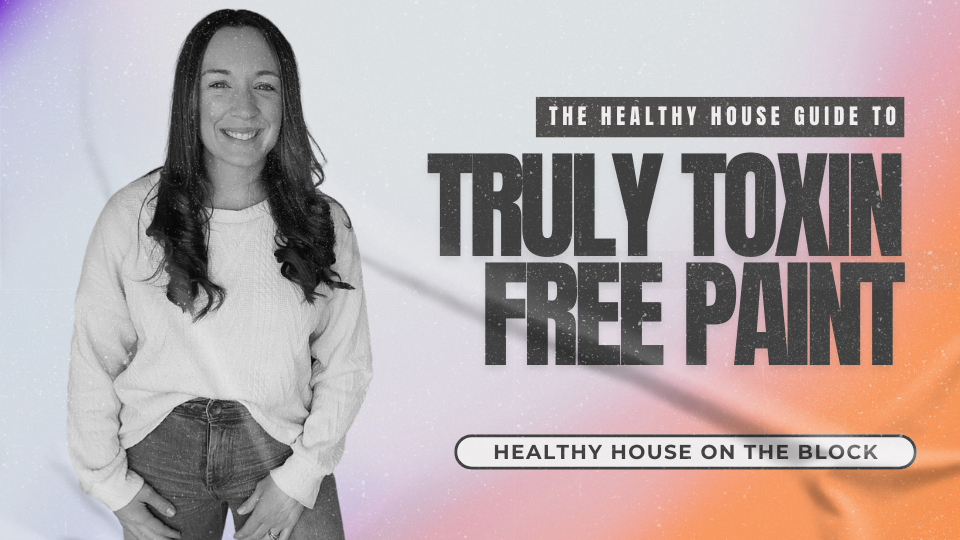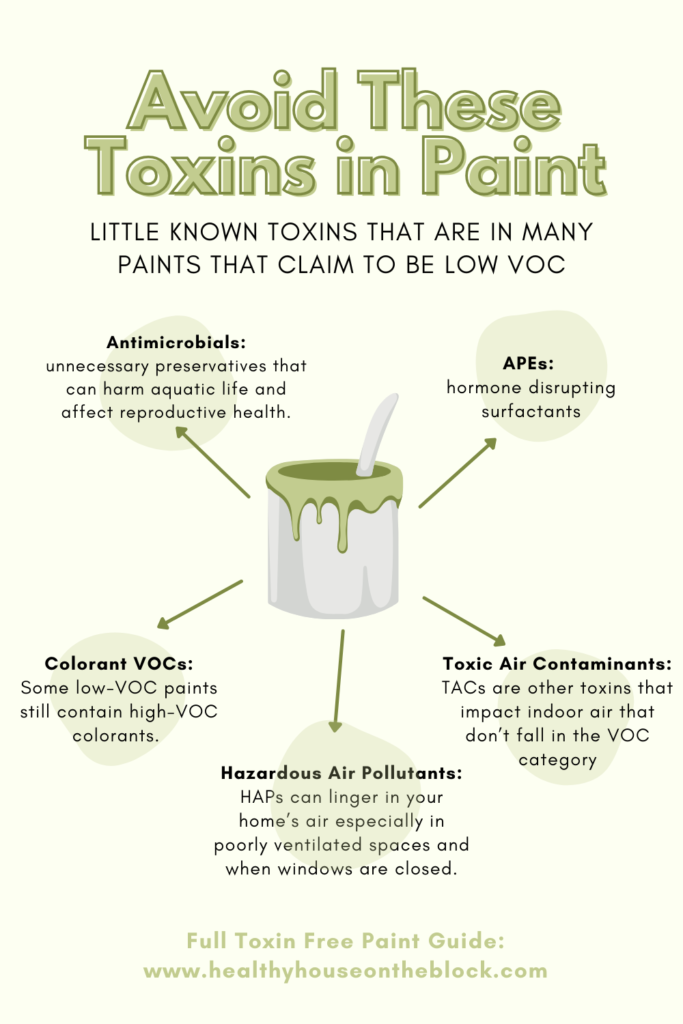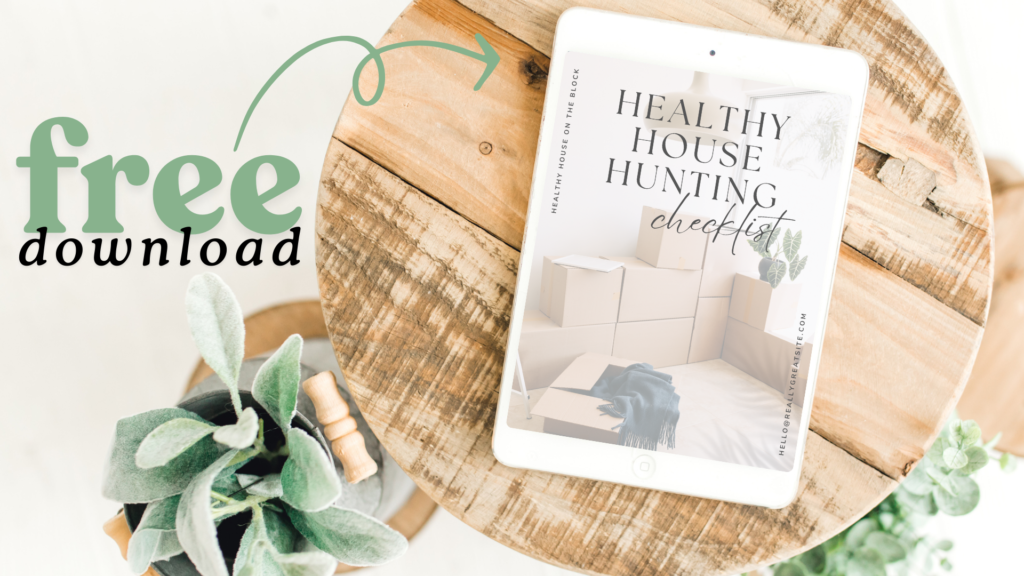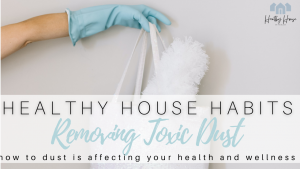
When you’re working toward a healthier home, paint might not be the first thing that comes to mind—but it should be. Non toxic paint is one BIG way to avoid bringing unnecessary toxins into your home.
Paint is big contributor to indoor air pollution, and many of the “low-VOC” options on the market still contain chemicals that can quietly undermine your family’s health. As a Building Biology Practitioner, I’ve seen firsthand how much of an impact indoor air quality has on our overall wellness—especially when it comes to hormone health, immune function, and our ability to truly heal.
The reality is that we spend up to 90% of our time indoors, often surrounded by materials and finishes that release harmful toxins into our breathing space. Over time, this contributes to what’s known as body burden—the accumulation of synthetic chemicals in the body that disrupt normal biological processes.
In this post, I’ll break down why conventional paint can be such a hidden hazard, how to decode labels like “low-VOC” and “non-toxic,” and most importantly, how to confidently choose paints that support your well-being instead of compromising it.
This isn’t about perfection—it’s about progress and practical steps you can take to create a home that promotes healing and resilience, one coat of paint at a time.


WHAT IS NON TOXIC PAINT?
APE Free: APEs, or Alkylphenol Ethoxylates are a group of chemicals that are used as surfactants in acrylic paint. This helps the paint create a tension between the liquid and solid form as it dries. This additive is not biodegradable and disrupts hormone production as well as causes reproductive harm and birth defects. (STUDY)
Free of AntiMicrobials: Antimicrobials are often added to paint to prevent bacteria in the product (give it a longer shelf life) as well as minimize the staining on the paint after it’s applied. Antimicrobials disrupt hormone production and have impacts on the reproductive system and on child development. On top of which, antimicrobials are harmful to our aquatic organisms and animals (INFORMATION)
No Colorant VOCs: Typically, the deeper the pigment of the paint, the more VOCs are typically in the paint. Opting for a lighter shade is generally a fool-proof way to find a more non toxic paint option with lower VOCs. But, you can also make sure the paint has no colorant VOCs added to it.
One VERY important thing to know about non toxic paint is that the VOC count on the paint DOES NOT include the VOCs in the colorant that will be added. To find out if and how much the VOC content is in non toxic paint, you’ll need to look at the products data sheet. You can also look to see if the product complies with the SCAQMD Rule 1113, which states that colorants MUST be low VOC.
No Base VOCs: This is EXACTLY what it sounds like. Every paint base has a rating of what the VOC content is. Long term exposure to VOCs has been linked to liver kidney and central nervous system damage and is rated as possibly carcinogenic. (EPA Information).
Beyond VOCs: Understanding HAPs and TACs in Paint
When it comes to creating a healthier indoor space, most people know to look for low-VOC or no-VOC paint. But there’s more to indoor air pollution than just VOC content. Paint can also contain and release Hazardous Air Pollutants (HAPs) and Toxic Air Contaminants (TACs)—two categories of harmful airborne chemicals that are not always labeled and often go unnoticed.
What Are HAPs?
Hazardous Air Pollutants (HAPs) are a group of chemicals identified by the U.S. Environmental Protection Agency (EPA) as known or suspected to cause cancer, reproductive toxicity, birth defects, respiratory issues, and other serious health conditions. These pollutants are commonly released during the manufacturing and off-gassing of conventional paint and coatings.
Some of the most common HAPs found in traditional paint products include:
Formaldehyde – A known carcinogen that can irritate eyes, nose, throat, and lungs
Benzene – A highly toxic solvent linked to leukemia and other blood disorders
Toluene – Harmful to the central nervous system and developing fetus
Methylene chloride – A likely human carcinogen and neurotoxin
Even after paint has dried, trace levels of HAPs can linger in your home’s air, especially in poorly ventilated spaces or in colder months when windows are closed.
What Are TACs?
Toxic Air Contaminants (TACs) is a classification used in states like California to track airborne chemicals that may cause cancer or non-cancer health effects like developmental harm or immune system suppression. The California Air Resources Board (CARB) monitors over 200 TACs—including many found in paint and coatings.
Some TACs overlap with HAPs, but the state-level monitoring is often more rigorous. California’s SCAQMD Rule 1113 (a standard for architectural coatings) is a good benchmark when selecting non toxic paint, as it sets strict limits on not just VOCs but also certain TACs in paint colorants and bases.
Why This Matters for Healthy Homes
Many “low-VOC” paints still contain these pollutants because current regulations only require VOC disclosure—not full transparency on all hazardous ingredients. This means a paint could be labeled low-VOC but still emit formaldehyde or other chemicals that can compromise your indoor air quality and overall health.
When choosing a non toxic paint, it’s important to look for brands that go beyond VOC claims and commit to being free from both HAPs and TACs. Certifications like Declare Labels, GreenGuard Gold, or Green Seal can help, but it’s just as important to read the Technical Data Sheets and look for full ingredient disclosure.
If a manufacturer doesn’t provide this info or avoids answering questions about HAPs or TACs, that’s a red flag.

HOW TO FIND THE GRAMS OF VOC PER LITER IN PAINTS
One of the best ways to find out exactly what is in a paint can is by searching Google for the paint type followed by “technical data sheet”. This will often bring up a webpage or a PDF that has a lot of very technical information. But, this is an excellent way to find if a paint really is non toxic paint.
Once in the document or on the webpage, use your search function (ctrl + F) and search for VOC. It should lead your right to their VOC content.
The only problem with using this method to search for VOC content in non toxic paint is that this often only applies to the base paint. You’ll need to do a search for a specific color, which isn’t always readily available.
If you can’t find the VOC content for a particular color, you’ll need to contact the manufacturer.

WHAT DOES THE GREENGUARD LABEL PROMISE IN NON TOXIC PAINTS
First, it’s important to know what the VOC content limits are for both low VOC and no VOC paints:
- LOW VOC paint is typically 50 grams per liter or less
- NO VOC is usually 5 grams per liter or less
The GreenGuard certification is a third party certification that takes into account the manufacturing and ingredients in paint. GreenGuard Gold often takes into account the special sensitivities of elderly and children when rating low emissions products.
The certification ensures that the product is free of more than 10,000 chemicals that are harmful to the indoor air. Greenguard certifications specifically focus on products that are used inside the home.
GreenGuard certifications are tested every year to make sure that the product still meets their strict standards.

MY TRUSTED NON TOXIC PAINT LINES
The Real Milk Paint Co.: Made of 100% organic materials, it’s really safe for all homes. It is a no VOC solution and you can either order it online or find a retailer.
Farrow and Ball: One of the reasons I love Farrow and Ball is because it’s tested within the UE, which has much higher standards than the US in terms of chemicals and toxins. It is a No-VOC paint with a water base which allows it to dry quickly. You can order their paint and samples online.
BioShield: Biosheild paint has zero solvents and is considered no VOC paint. Their colors have no VOCs in them as well as they are colored with clay pigments. This is a great option for a really natural paint as it contains virtually no chemicals or toxins. You can order it online or find a retailer.
ECOS Paint: This paint is zero VOC and is certified by the Declare Label, which is a third party certification that verifies ingredients. ECOS Paints has also chosen not to use other chemicals that are not regulated as VOCs. Their pigments are also VOC free, which makes this an easy choice for paint. You can order paint and samples online.
AFM SafeCoat: One thing I love about AFM SafeCoat is their transparency. They have data and spec sheets available on all of their products. Their paint is true zero VOC and they list out each of their ingredients on their website. Their paint is water based and contains no toxic chemicals. The best place to order AFM SafeCoat is at the Green Design Center website.
Healthy Paint Co. (Formerly Anna Sova): The unique thing about this paint is that it’s made with 94% food ingredients. Things like food grade bamboo, food emulsifiers, and milk casein. They also have pigments that are imported from Germany, which contain no VOCs and are APE free. This paint is a no VOC paint and you can order paint and samples online.
Green Planet Paint: This paint is made with mineral colors and virtually no VOCs. They don’t add any chemicals to their paints or tints, and they are all plant based. You can order Green Planet Paint on their website or find a local dealer.
In a perfect world, we’d always have access to the cleanest, safest products. But in reality, sometimes we need to make the best choice we can with what’s on hand. Choosing a non toxic paint—even if it’s not the “perfect” brand—is still a step in the right direction.
Every coat of paint you apply is either protecting your indoor air—or polluting it. The more informed your choices, the healthier your home becomes.
Share this:
- Click to share on Facebook (Opens in new window) Facebook
- Click to share on LinkedIn (Opens in new window) LinkedIn
- Click to share on Reddit (Opens in new window) Reddit
- Click to share on Pinterest (Opens in new window) Pinterest
- Click to print (Opens in new window) Print
- Click to share on X (Opens in new window) X








thank you for all your time and effot to share this
You’re welcome, Terry!!
Great read – any thoughts on Linseed Oil Paint ie Allback from Sweden ?
From what I understand this is raw or cold pressed linseed oil, which is completely non-toxic (you want to avoid boiled linsdeed). Otherwise, Heritage Natural Finishes and Earthpaint are two great brands of toxin free linseed oil.
I’ve heard that some eco paints can devlop mold problems – do you know much about this?
I haven’t heard this, Steph. I would imagine it’s dependent on the humidity levels in the area being painted.
Pingback: Non-Toxic Wallpaper » Healthy House on the Block
Pingback: Creating a Clean, Happy Home from the Inside Out - Jon and Jen Rosario™